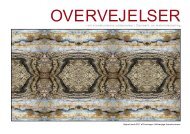Læs her - Uafhængige Scenekunstnere
Læs her - Uafhængige Scenekunstnere
Læs her - Uafhængige Scenekunstnere
You also want an ePaper? Increase the reach of your titles
YUMPU automatically turns print PDFs into web optimized ePapers that Google loves.
City of Oslo, and connected our arguments to the city planning strategies for<br />
the new city area Aker Brygge.<br />
The BBT theatre opened with two beautiful stages – black boxes – the main<br />
stage could host 220 capite per performance, the small one around 80.<br />
As the state financed the production costs for the companies, the City of<br />
Oslo took responsibility of a venue that could present the independent field in<br />
Norway. The City of Oslo also established a grant to support the companies.<br />
The model was truly democratic, and it was a goal to keep the costs of arts<br />
administration down. The model of a presenting rental theatre was established.<br />
You could book you and your company in for three or four days, paying an<br />
expensive rent. You had the minimum of technological equipment, remember<br />
the independent field was a touring field; they used to bring everything with<br />
them, your own technicians, audiovisual equipments, lightning. The companies<br />
themselves were also responsible for the entire PR. They just got the key to<br />
the theatre, and then they were on their own. This way about 80 productions<br />
were presented per year.<br />
It was – as I said – quite democratic. However, a theatre venue without a<br />
professional running platform, regarding the PR, the technological recourses,<br />
both humans and equipment gets no clear and understandable profile and<br />
no credibility, neit<strong>her</strong> by the artists nor by the audience, or by the politicians.<br />
Neit<strong>her</strong> in the city level nor at the Parliament. The model resulted in big gaps<br />
regarding quality and the various professional artistic levels visible in a non-<br />
favourable way. As an audience, you never knew the quality of the work.<br />
It was so expensive to rent the theatre, so you could only perform two or three<br />
times. It was impossible to build up a stabile audience and an interesting<br />
22<br />
artistic profile in a city with lots of cultural offers every evening. T<strong>her</strong>efore, in<br />
this model t<strong>her</strong>e was no co<strong>her</strong>ency between the City giving the support and<br />
the theatre philosophy of presentation. The city of Oslo took on to the profile<br />
problems, and started to discuss the model, without providing the resources to<br />
solve the financial trap connected to the rental model. The only thing they did<br />
was to delegate the administration of the grant to the theatre itself, to clarify<br />
the co<strong>her</strong>ency between the grant and the presenting profile. But it did not<br />
solve the deep challenges. We had to build an artistic profile, to develop a<br />
relationship to the audience of Oslo. And in the end – the companies still had<br />
to pay to perform!<br />
In the period of 1990 – 1995, the strategy of developing the theatre from a<br />
“Spillested på dugnad” [venue of voluntary work] to a professional programming<br />
theatre was outlined.<br />
One main goal was to increase the artistic status of the independent field as<br />
such.<br />
We engaged a managing and artistic director of the theatre. We wanted to<br />
be a part of the professional institutions organisation NTO [Norsk Teater- og<br />
Orkesterforening], in order to be accepted as a professional theatre. We had<br />
to develop a high technical service standard.<br />
To the question of artistic profile: How can a theatre based on rent incomes<br />
develop a significant aesthetic profile? With companies who rent the theatre<br />
some few days, performing for the income at the door? Companies representing<br />
a variety of expressions? To rent the theatre, the companies were dependent<br />
on getting financial support from different foundations toget<strong>her</strong> with the income



